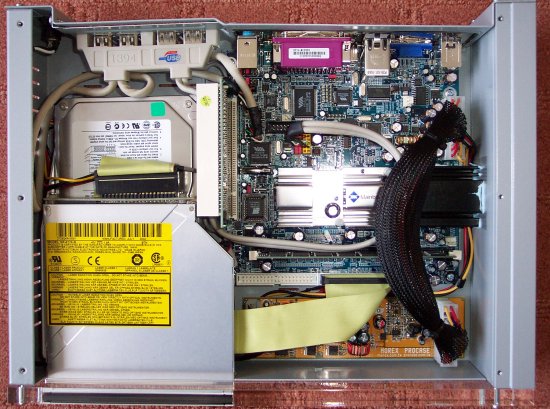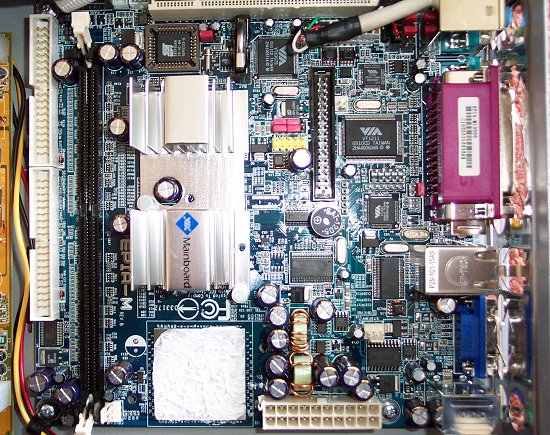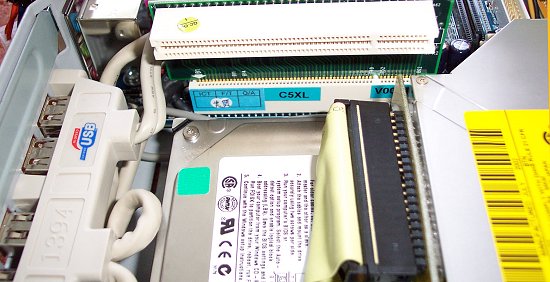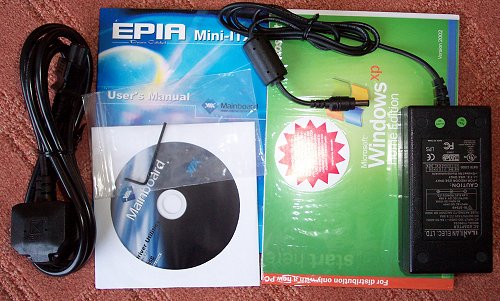Internal musings
Stripping this beauty down to her bare essentials is simply a matter of removing six small screws with a supplied Allen key.

A mix of standard and laptop-sized components in a steel case that measures 340mm wide x 255mm deep x 63mm high. The primary advantage of this design is in doing away with fans completely, both from the CPU and PSU (which is located externally). Fan-less running, really, is only accomplished through using extremely low power components. The low power mantra has to start from the CPU and power supply.
Removing away a few of the obstructing wires gives us a view of the clever DC-to-DC converter

Simple physics tells us that the total wattage ability of the PSU is around 55w (12v x 4.58A). The converter feeds this power to the various components. If you imagine that a single 3.2GHz Pentium 4 can eat over 70w of power on its own, the need to specify a lower power solution is immense. One slight area of concern is Morex's own recommendation that fan-less chassis not be used with this particular PSU and DC-DC converter combination. 24 hours of stability seemed to suggest that no immediate problems would be encountered.

With that in mind, Tranquil have chosen to go with VIA's EPIA M10000 motherboard - CPU combination. The feature-rich motherboard is tooled up with a whole manner of features, as evidenced by the aforementioned back panel. Indeed, we reviewed this very motherboard in the not too distant past, so rather than regurgitating all of its specification, a quick jump to here will provide one with the necessary background reading.
This package, too, uses a 1GHz Nehemiah CPU, well hidden under a generous amount of thermal paste. A floppy port is specified on the EPIA M10000, but Tranquil decide not to use it. The recent emergence of handheld USB storage devices and the ability of a number of motherboards to boot from said devices have almost replaced the archaic legacy floppy drive. This EPIA has the ability to boot from USB CD-ROM, Floppy, ZIP and hard drives. Note the single DIMM slot on the left. We reckon that a lone 512MB module would be enough to allow the Tranquil to carry out its intended operations.
Have a look at the top picture and then feast your eyes on the one just above, can you see how the passive cooling is applied ?.

The right-hand side panel is actually part of the passive heatsink. Once screwed back together to form the complete base unit, the finned side absorbs the CPU's heat such that it gets quite warm after extended use. The opposite side, though, remains generally cool.

The half height nature of the Tranquil PC dictates that a riser card be used to provide the single 32-bit, 33MHz PCI slot. Our only concern is that components on the inserted PCI card may interfere with the cabling attached to the slim Panasonic SR-8176 8x DVD-ROM drive. The PCI slot will be used in the same way as many Shuttle XPC's. Tranquil offer the buyer three optical solutions, from a basic CD-ROM drive to a combination CD-RW / DVD-ROM drive, all in the slim format, and all connected to the system via a laptop-to-desktop adapter. The IDE drive is a standard 3.5" Seagate 80GB Barracuda IV, one that can be upgraded to the 120GB model. Seagates are renowned for their whisper-quiet operation, so it's inclusion is an eminently sensible one. A handy multi-bracket, supplied with the EPIA M10000, is how the Tranquil is equipped with dual USB 2.0 and FireWire ports on the rear.

The accompanying bundle is more rudimentary than spectacular. Windows XP: Home Edition with integrated Service Pack 1 provides the O.S backbone. A driver CD with all the requisite drivers is present, as is the manual, Allen key and PSU.
Compact, fan-less and stylish are three words that spring to mind when initially appraising this PC from a hardware point of view. Let's now see if all the features work in tandem. We'll also investigate just how quiet it is, because that, obviously, is the primary reason for shortlisting a Tranquil PC in the first place.









